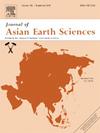Controls on Mn carbonate precipitation in the formation of Cryogenian Datangpo manganese deposits, southeastern Chongqing, South China
IF 2.4
3区 地球科学
Q2 GEOSCIENCES, MULTIDISCIPLINARY
引用次数: 0
Abstract
The Cryogenian Datangpo Formation (ca. 663–654 Ma) in South China hosts globally significant sedimentary Mn deposits whose genetic mechanisms remain debated. To clarify their formation processes, the present study conducted integrated petrographic, mineralogical, and geochemical analyses of a new drill core from the Xiaochayuan subbasin (Nanhua Basin), southeastern Chongqing. Geochemical evidence show that Mn was predominantly derived from hydrothermal activity associated with extensional tectonics in the Nanhua Rift Basin during the breakup of the Rodinia Supercontinent. Variations in the Chemical Index of Alteration (CIA), together with regional correlations, indicate that Mn accumulation occurred under fluctuating cold and warm climatic conditions following the Sturtian glaciation. Enrichment of redox-sensitive elements and consistently low Mo/TOC ratios demonstrate Mn carbonate-bearing strata were deposited in a highly restricted, anoxic-euxinic environment. Positive Ce anomalies coupled with distinctly negative δ13Ccarb values in the Mn carbonate rocks, provide compelling evidence for Mn oxide reduction mediated by organic matter degradation. The negative correlation between Mn content and δ13Ccarb further supports that anaerobic oxidation processes generated HCO-3 supersaturation in porewaters. Microtextural analyses reveal that authigenic minerals with abundant nucleation sites, such as dolomite, pyrite and quartz, acted as catalytic substrates that facilitated Mn carbonate precipitation through heterogeneous nucleation. Collectively, these results establish a genetic framework in which organic matter accumulation, post-glacial climatic oscillations, hydrothermal influx, oceanic anoxia, and intensified continental weathering synergistically controlled the formation of these black shale-hosted Mn deposits.
渝东南深冷系大塘坡锰矿床形成过程中碳酸锰沉淀的控制因素
华南低温系大塘坡组(约663-654 Ma)拥有全球重要的沉积型锰矿床,其成因机制仍有争议。为明确其形成过程,本文对渝东南小茶园次盆地(南华盆地)新钻取的岩心进行了岩石学、矿物学和地球化学综合分析。地球化学证据表明,锰主要来源于Rodinia超大陆分裂期间华南裂谷盆地与伸展构造相关的热液活动。化学蚀变指数(CIA)的变化以及区域相关性表明,在斯图特冰期之后,Mn的积累发生在冷暖气候条件的波动下。氧化还原敏感元素的富集和持续较低的Mo/TOC比值表明,含锰碳酸盐岩地层沉积在高度受限的缺氧-富氧环境中。正Ce异常与明显负δ13Ccarb值在Mn碳酸盐岩中结合,为有机质降解介导的Mn氧化物还原提供了强有力的证据。Mn含量与δ13Ccarb呈负相关,进一步支持厌氧氧化过程在孔隙水中产生HCO-3过饱和。微观结构分析表明,白云石、黄铁矿和石英等自生矿物具有丰富的成核位点,是促进碳酸锰非均相成核沉淀的催化基质。综上所述,这些结果建立了有机质聚集、冰期后气候振荡、热液流入、海洋缺氧和大陆风化加剧共同控制这些黑色页岩含锰矿床形成的成因框架。
本文章由计算机程序翻译,如有差异,请以英文原文为准。
求助全文
约1分钟内获得全文
求助全文
来源期刊

Journal of Asian Earth Sciences
地学-地球科学综合
CiteScore
5.90
自引率
10.00%
发文量
324
审稿时长
71 days
期刊介绍:
Journal of Asian Earth Sciences has an open access mirror journal Journal of Asian Earth Sciences: X, sharing the same aims and scope, editorial team, submission system and rigorous peer review.
The Journal of Asian Earth Sciences is an international interdisciplinary journal devoted to all aspects of research related to the solid Earth Sciences of Asia. The Journal publishes high quality, peer-reviewed scientific papers on the regional geology, tectonics, geochemistry and geophysics of Asia. It will be devoted primarily to research papers but short communications relating to new developments of broad interest, reviews and book reviews will also be included. Papers must have international appeal and should present work of more than local significance.
The scope includes deep processes of the Asian continent and its adjacent oceans; seismology and earthquakes; orogeny, magmatism, metamorphism and volcanism; growth, deformation and destruction of the Asian crust; crust-mantle interaction; evolution of life (early life, biostratigraphy, biogeography and mass-extinction); fluids, fluxes and reservoirs of mineral and energy resources; surface processes (weathering, erosion, transport and deposition of sediments) and resulting geomorphology; and the response of the Earth to global climate change as viewed within the Asian continent and surrounding oceans.
 求助内容:
求助内容: 应助结果提醒方式:
应助结果提醒方式:


